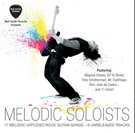Language of Music
I would like to talk to you today about a very controversial concept in the world of guitar: The subject of soul in your music. There is a lot of stuff that may seem off-subject but I encourage everyone who reads this to make it all the way through before deciding it’s a waste of time.
After a lot of YouTube and living in Las Vegas, experiencing the local music scene including my own bands, I’ve noticed that bands that are technically talented seem to forget about caring for the music on an intimate level. Rather, they only think about making it sound cooler and more technical. I’ve also seen the bands who wish they were SRV, and let me tell you, they have completely forgone technique in favor of bending and vibrato and making faces that show how into it they are.
Here is the truth, you need BOTH technical talent and an UNDYING passion for music. They act in harmony, like yin and yang. More importantly, Understanding both is crucial to having a large musical vocabulary. Anyways, that was a big long intro. Here’s the lesson…
When writing and learning, I am a huge believer that technicality comes first. It does you no good to be passionate and soulful if you don’t know the music. I mean KNOW the music. When writing the solo for my most recent single, “In the Flesh,” I broke down the music to an extreme level. First, I wrote the progression with no analysis and no preconception as to what I wanted except that it was in D. I came up with the following:
W W W E||--0----------------|--0----------------|--0----------------| B||--3----------------|--0----------------|--1----------------| G||--2----------------|--2----------------|--2----------------| D||--0----------------|--2----------------|--0----------------| A||--3----------------|--3----------------|--3----------------| E||--1----------------|--0----------------|--3----------------| A||--0----------------|--0----------------|--0----------------| W W W W --0----------------|--0----------------|--0----------------|--0----------------| --0----------------|--0----------------|--3----------------|--3----------------| --4----------------|--2----------------|--0----------------|--2----------------| --0----------------|--4----------------|--2----------------|--0----------------| --4----------------|--2----------------|--3----------------|--3----------------| --2----------------|--0----------------|--0----------------|--1----------------| --0----------------|--0----------------|--0----------------|--0----------------|
After writing the progression, I listened to it, determined I liked it and took the next step: naming the chords. Those of you theoretically inclined will notice that some of the chords could have multiple names, I’ll address that. The progression as it turned out was a measure a piece of the following chords in order: Dm9/A, Am9 -7, Am11 -9, Bm11/A, Em11 -3, Cadd9/A, Dm9/A.
We’re almost there! The next step is actually two steps combined into a larger step: Analysis. Here I did a Roman Numeral analysis of the progression and named the scales that could be associated with each chord. The reason I combined the two steps is that they serve the same overall function of pre-composition (not like Kole’s, though everyone should read his lesson on it!).
It’s important to know that there is always more than one way to analyze a piece and tons of scales to match each chord, that’s part of individuality. The roman numerals tell you the relationship between the chords and the key. This gives you a frame of reference for substitution, modulation, and a lot of other concepts to use in your writing which you can learn about elsewhere. Here’s what I came up with: i9 v9 -7, v11 -9, vi11, ii11 -3, VII13, i9.
For every chord, I looked at the notes within and determined several scales which contained most or all of the notes in each. After compiling the list of scales and trying each (potentially, every note in the chord has a mode that will match over top) I came up the following scalar progression: D Aeolian, A H. Minor, A Aeolian, B Dorian, E Mixolydian, C Ionian, D Aeolian.
Now the fun part! Writing! I cannot stress enough the importance of hearing what you’re playing and the chord progression at exactly the same time. Here’s why: as you write, you will notice some notes that are a little more dissonant or downright blue against the chord playing. These things have to be used tastefully. But I digress.
The method for writing your solo includes a LOT of improvisation. The method I use for starting from scratch is playing each scale in time with the music and taking up the entire space of the chord, in this case, simple whole notes.
To express yourself, you need the language. You need the mood, you need to know what you want to say. This is something that can’t be taught, only learned. To find the soul of the music, you have to mean what you write and you have to mean what you play! There’s no room for messing around if you are serious about your music. To me, music is the language of Truth, it can deliver a message in a way we can’t with words. Everything preceding this paragraph was about learning the language of the soul, the grammar, the alphabet, sentence and paragraph structure, the flow of the language. Now you find the message and tell the world! Every soul has a song!
click here to download the accompanying mp3 for this lesson










